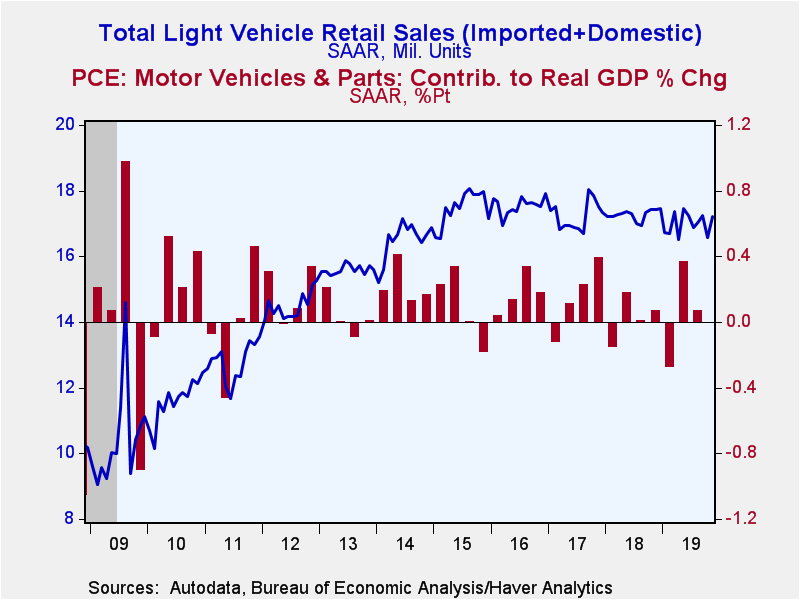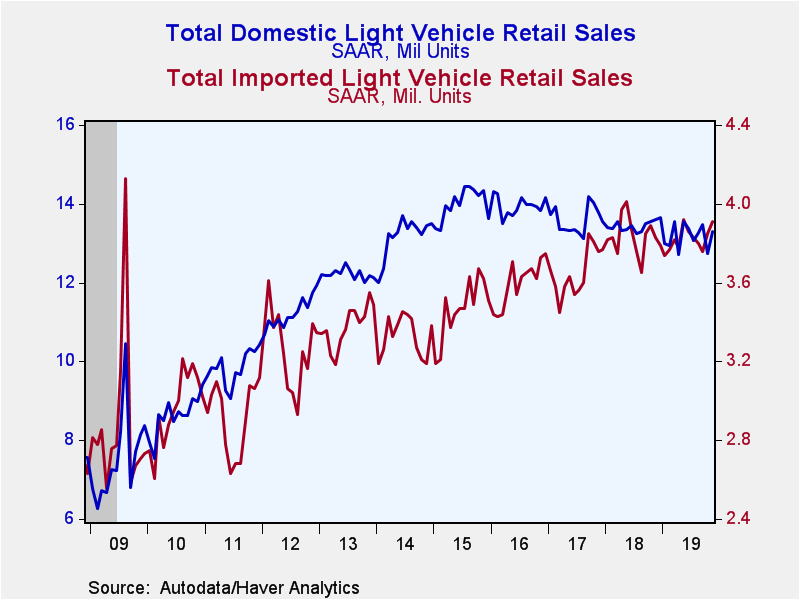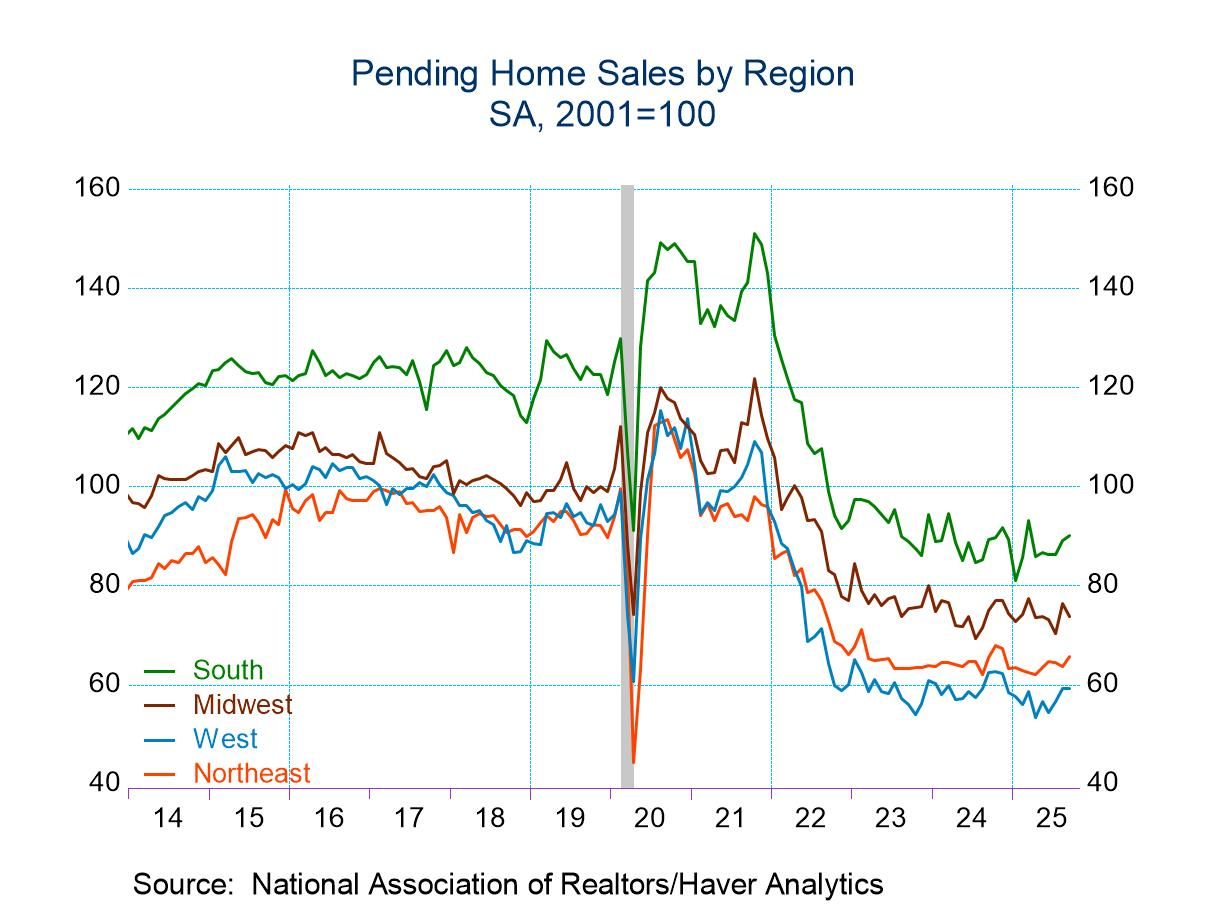 Global| Dec 03 2019
Global| Dec 03 2019U.S. Light Vehicle Sales Bounce Back
by:Tom Moeller
|in:Economy in Brief
Summary
The Autodata Corporation reported that sales of light vehicles during November rose 3.7% (-1.3% y/y) to 17.20 million units (SAAR) and reversed most of the prior month's decline to 16.58 million. During the first eleven months of [...]
The Autodata Corporation reported that sales of light vehicles during November rose 3.7% (-1.3% y/y) to 17.20 million units (SAAR) and reversed most of the prior month's decline to 16.58 million. During the first eleven months of 2019, sales averaged 17.00 million units versus 17.27 million during all of 2018.
Sales of light truck sales increased 3.6% both m/m and y/y to 12.52 million units. Purchases of domestically-made light trucks rebounded 3.4% (2.8% y/y) to 9.95 million units after October's 4.1% decline. Sales of imported light trucks increased 3.6% (6.6% y/y) to 2.57 million units, the fifth straight month of increase. Imported truck sales have roughly doubled in the past five years.
Trucks' share of the U.S. light vehicle market eased from the record to 72.8%, but remained up from a low of 48.8% during all of 2012.
Auto sales rose 4.2% (-12.5% y/y) to 4.68 million. That made up most of October's decline and compares to a peak level of 7.90 million unit sales during all of 2014. Purchases of domestically-produced cars increased 7.4% (-14.8% y/y) to 3.34 million units and moved up slightly from the 2009 low. Sales of imported cars fell 2.9% (-6.3% y/y) to 1.34 million units and reversed October's rise.
Imports' share of the U.S. vehicle market fell to 22.7%, but remained in an up trend. Imports' share of the passenger car market fell to 28.6%. Imports share of the light truck market held steady at 20.5% and remained up from the 12.0% low in January 2015.
U.S. vehicle sales figures can be found in Haver's USECON database. Additional detail by manufacturer is in the INDUSTRY database.
Who Pays the Tax on Imports from China? from the Federal Reserve Bank of New York is available here.
| Light Weight Vehicle Sales (SAAR, Million Units) | Nov | Oct | Sep | Nov Y/Y % | 2018 | 2017 | 2016 |
|---|---|---|---|---|---|---|---|
| Total | 17.20 | 16.58 | 17.23 | -1.3 | 17.27 | 17.23 | 17.55 |
| Autos | 4.68 | 4.49 | 4.79 | -12.5 | 5.49 | 6.32 | 7.09 |
| Domestic | 3.34 | 3.11 | 3.44 | -14.8 | 4.00 | 4.58 | 5.20 |
| Imported | 1.34 | 1.38 | 1.35 | -6.3 | 1.49 | 1.74 | 1.89 |
| Light Trucks | 12.52 | 12.09 | 12.44 | 3.6 | 11.79 | 10.90 | 10.46 |
| Domestic | 9.95 | 9.62 | 10.03 | 2.8 | 9.44 | 9.00 | 8.76 |
| Imported | 2.57 | 2.48 | 2.40 | 6.6 | 2.35 | 1.91 | 1.70 |
Tom Moeller
AuthorMore in Author Profile »Prior to joining Haver Analytics in 2000, Mr. Moeller worked as the Economist at Chancellor Capital Management from 1985 to 1999. There, he developed comprehensive economic forecasts and interpreted economic data for equity and fixed income portfolio managers. Also at Chancellor, Mr. Moeller worked as an equity analyst and was responsible for researching and rating companies in the economically sensitive automobile and housing industries for investment in Chancellor’s equity portfolio. Prior to joining Chancellor, Mr. Moeller was an Economist at Citibank from 1979 to 1984. He also analyzed pricing behavior in the metals industry for the Council on Wage and Price Stability in Washington, D.C. In 1999, Mr. Moeller received the award for most accurate forecast from the Forecasters' Club of New York. From 1990 to 1992 he was President of the New York Association for Business Economists. Mr. Moeller earned an M.B.A. in Finance from Fordham University, where he graduated in 1987. He holds a Bachelor of Arts in Economics from George Washington University.










